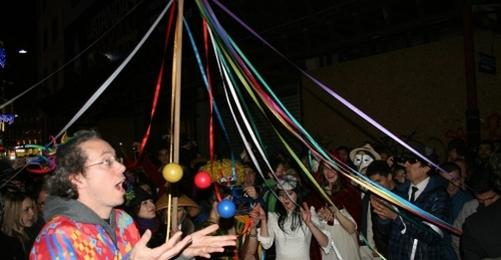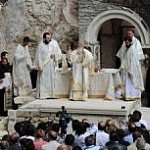The Greek Tatavla Baklahorani Carnival gave Istanbul's Beyoğlu district a colourful face on Sunday and Monday (26/27 February). A crowd of costumed dancing people 'occupied' Taksim on Sunday and continued their celebrations in Feriköy on Monday.
The cheerful masked parade was accompanied by music when they proceeded from Feriköy to Kurtuluş as the last stop of the celebrations. The party was carried on at the Tatavla Restaurant where the music groups Tatavla Keyfi, Laterna and Perapolis performed on stage as well as the Fener Greek High School Dance Group.
Tatavla Baklahorani
"The spring sun vitalized yesterday's carnival festivities. Thousands of people filed into Tatavla from the Akarca Hill and the Kurtuluş Avenue. The road was so crowded that it was blocked between the Pangaltı Catholic Cemetery and the Church of Saint Dimitrios in Kurutluş".
"The centre of the festivities was the Ararat Club as usual. While the area in front of the church was turned into a public festival area where people were performing traditional folk dances, mobile photographers were doing good business with customers waiting in line to have a souvenir picture taken".
8 March 1938/Apoveymatini newspaper.
The Baklahorani Carnival is traditionally celebrated by the Greeks in Istanbul at the brink of spring on the last two days before Lent. It was banned in 1941. The first large-scale celebrations since the ban was lifted in 2010 were done after 71 years in Takism on Sunday.
The Baklahorani Carnival has its root in ancient pagan traditions.
The three-week period is called "Apokria" by the Greeks in Istanbul and usually falls to the end of February or beginning of March. Before its ban, the carnival was a huge event in Beyoğlu that included all inhabitants and not only the Greek.
The celebrations were usually held in the districts of Kurtuluş, Galata and Pera. The name stems from the old word for Kurtuluş: 'Tatavla'.
Shrove Monday is the last day before the Lent for the Greek Orthodox community that extends till Easter.
Be prepared for the party...
* A mask is essential. Some men cover their faces with flour, some paint it completely black.
* A part of the Greek youth wears the 'Fustenella' (folded skirt) traditional Greek dress. Women wear short-sleeve blue and green dresses with a low-cut décolleté. Some women also dress up in a lady's suit with velvet shorts, black silk stockings and a silver sailor hat. They always wear masks made of velvet or silk.
* Each district prepares costumes related to a certain theme.
* People from one district dress up as bandits, others wear the original fustenella. People are dancing rural folk dances with music coming from traditional instruments. In another district, people dress up like Anatolian porters with baggy trousers, full-gathered knee breeches and turbans. They are moving in rows of ten people carrying a heavy pole on their shoulders with a single egg attached to a chain.
* People dressed up as doctors help women to give birth in the middle of the street.
* People are carrying 'dead' persons in coffins on the street. Priests, widows and relatives lament in funeral corteges.
* The costumed people are called the "fool's regiment". The term "Carnival Fool" is a frequently used phrase in Istanbul that is derived from the Tatavla Carnival. (IC/VK)
Source: Istanbul Greek Community internet site.







